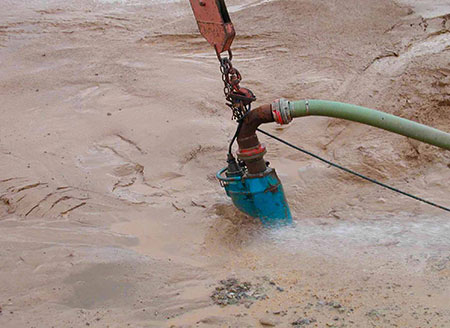Many construction sites require the excavation of materials, such as soil, rock, sand and clay. These sites can be in the form of trenches, pits, caissons, cofferdams and more. For all of these forms, one important environmental factor to consider when managing a job site is water.
Water will naturally flow to the lowest point in an area, and the excavated region will collect water from rain or a high water table. Excess water can make the surrounding material and working environment unstable. For proper operation of machinery and worker safety, a dry work site is necessary. Engineers often employ wellpoints, eductor wells, sumps and deep wells to access this water, making dewatering pumps necessary. Choosing the right pump can make the difference between a safe or unsafe working area.
Choosing the Right Pump Type
When choosing a pump, it is important to consider the properties of the water at the particular job site. These characteristics will determine the type of pump and materials of construction needed.
For example, clean water has minimal contaminants and sediment, making typical cast iron pumps a viable option. On the other hand, water with a high amount of solids, such as sand or mud, requires slurry or trash pumps with harder impeller materials, such as high-chrome cast iron, to resist abrasion.

IMAGE 1: Submersible pump for dewatering at a construction site (Image courtesy of Tsurumi America)
Many pumps are designed with an agitator attached to the impeller to stir up the solids, preventing solids from settling near the suction. It is important to know what the water contains, as pumps not meant for solids can clog or suffer damage.
If the site contains acidic water or other pollutants, the parts within the pump must be compatible to handle such damaging conditions. Those applications may require materials such as stainless steel housings or fluoropolymer elastomers for chemical resistance. Pumps encountering seawater or brackish water may require sacrificial anodes to prevent galvanic corrosion.
Meeting the Required Duty Point
The next step is to choose the pump with the right performance for the target duty point. The dewatering plan should include a proposed piping system plan that details the required flow rate and geometry of the system. This will include pipe length, diameter and elevation change. The plan should also account for any settling of solids in piping. A minimum velocity is needed depending on the type of solids and that velocity is dependent on the pipe size and flow rate.
The pressure loss, or head loss, can be determined due to friction by using these parameters with a friction loss calculator. In general, a longer pipe, smaller diameter and higher flow rate leads to higher friction loss. The total elevation change, from the water level and the pipe discharge height (static head), plus the total friction loss head, will give the total dynamic head (TDH). The proposed pump will need to achieve this TDH and flow rate, or target duty point.
Pump horsepower or discharge size is not indicative of performance, as a manufacturer can have dozens of models for each size. The performance curves should be looked at instead. The chosen pump should have a curve closest to the target duty point, while also being as close as possible to its best efficiency point (BEP)—ideally within 30 percent. A pump will rarely achieve the exact target duty point, so the engineer will make a judgment call to balance the operating duty point with the proximity to the BEP.
Running too far left of the BEP can cause an imbalance of forces on the pump shaft, leading to mechanical seal and bearing failures. The water will also recirculate inside the pump casing, wearing it down in the presence of abrasives. On the other hand, running too far right of the BEP can also lead to imbalanced forces on the shaft as well as cavitation, which will damage the impeller.
Selecting the Right Power Source
There are two options for a power source: engine- or electric-powered pumps.
Engine-powered pumps require fuel to operate, while submersible pumps are typically powered by generators or line power.
The pumps should be sized according to the startup amp draw and type of power connection needed. For example, if a generator is providing power, make sure the pumps have the right plugs.
Choosing the Right Controls
For larger sites with more sophisticated pumping systems, water level sensing devices may be needed to maintain a certain water level. These devices, such as floats or water level transducers, can be integral to the pump or connected
to a central controller. Typically, there is an “on” float to turn the pump on at high water levels and an “off” float to turn it off at a set low water level. The “off” float should be placed above a submersible pump’s continuous running water level to prevent it from running dry or experiencing cavitation.
Installation & Operation
Precautions must be taken to prevent any damage. If the pump has to be lowered, it should be lowered with a rope or chain, not the power cable. This is crucial to ensuring no damage occurs to the cable, which could lead to motor failure.
For three-phase power, test the startup reaction of the submersible pump to ensure proper rotation. The pump should turn in the opposite direction of proper impeller rotation. The pump should not operate below its given continuous running water level and should be monitored either manually or with an on/off float system.
For larger sites with long-term dewatering, proper engineering is imperative to account for power draw and piping installations.

